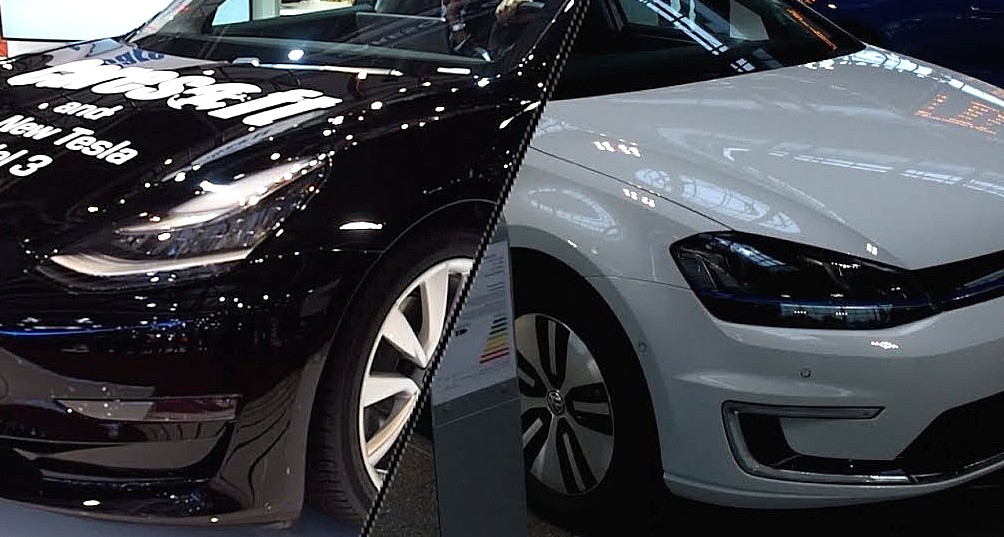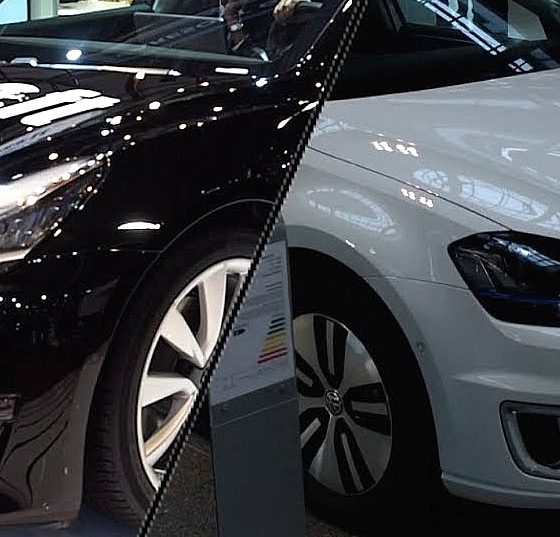

News
Tesla rival Volkswagen takes stand against FUD on electric cars’ carbon footprint
Tesla rival Volkswagen has taken a stand against a debunked yet insistent argument against all-electric vehicles. In a recent study involving one of its most popular vehicles, the German automaker declared that EVs have a smaller carbon footprint than their internal combustion-powered counterparts, even if they are not charged from renewable sources.
Volkswagen used two of its vehicles, a Golf TDI and an e-Golf for its study. The e-Golf produced 57g/km of carbon dioxide per vehicle, which is higher than the Golf TDI’s 29g/km of CO2 per vehicle during its production phase. This is the only time that the electric car’s carbon footprint exceeded that of its diesel counterpart, since when it came to charging and operating the vehicles, the e-Golf proved far cleaner than its diesel-powered sibling.
Driving the Golf TDI resulted in an average CO2 output of 111g/km, which was notably higher than the 62g/km CO2 produced by the e-Golf when charging. Volkswagen estimated that this figure could drop to as low as 2g/km if the electric car were charged using renewable energy. With these calculations in mind, the German carmaker noted that the diesel-powered Golf TDI produced an average of 140g/km over its lifetime. The e-Golf, on the other hand, produced an average of 119g/km over its lifetime.
The Volkswagen-backed study mirrors the findings of a previous analysis by research organization BloombergNEF, which concluded that the CO2 emissions produced by electric vehicles charged from non-renewable power were still 40% lower than cars operating with internal combustion engines. This gap, of course, is set to get smaller with the introduction of more efficient battery technology and more sustainable automotive manufacturing processes.
Credit is due to Volkswagen for taking a stand against a persistent piece of misinformation that has been peddled for years. The study, if any, is yet another sign that one of Germany’s largest of automakers is beginning to take the upcoming electric car revolution seriously.
This is highlighted by Volkswagen’s recent public comments, as shown when the carmaker acknowledged Tesla for establishing that the demand for electric vehicles is there. The company also made headlines when CEO Herbert Diess encouraged BMW and Daimler to commit to an all-electric future. After Das Auto’s agreement, BMW member of the board Klaus Fröhlich confirmed that Germany would be moving away from other alternative forms of propulsion like hydrogen, as the country’s automakers will be focusing on all-electric vehicles instead.
While Volkswagen is arguably one of Tesla’s loudest rivals with its constant releases of concept all-electric vehicles that are yet to enter production, the company has shown some earnest interest in the electric car maker’s work. During the final days of Elon Musk’s short-lived attempt to take Tesla private last year, the CEO received a number of offers from investors willing to fund company’s privatization at $420 per share. The deal, which was estimated to cost around $30 billion, attracted a number of prominent investors, one of which was none other than Volkswagen AG.
Volkswagen’s electric car emissions study could be accessed here.

News
Elon Musk’s Grokipedia surges to 5.6M articles, almost 79% of English Wikipedia
The explosive growth marks a major milestone for the AI-powered online encyclopedia, which was launched by Elon Musk’s xAI just months ago.

Elon Musk’s Grokipedia has grown to an impressive 5,615,201 articles as of today, closing in on 79% of the English Wikipedia’s current total of 7,119,376 articles.
The explosive growth marks a major milestone for the AI-powered online encyclopedia, which was launched by Elon Musk’s xAI just months ago. Needless to say, it would only be a matter of time before Grokipedia exceeds English Wikipedia in sheer volume.
Grokipedia’s rapid growth
xAI’s vision for Grokipedia emphasizes neutrality, while Grok’s reasoning capabilities allow for fast drafting and fact-checking. When Elon Musk announced the initiative in late September 2025, he noted that Grokipedia would be an improvement to Wikipedia because it would be designed to avoid bias.
At the time, Musk noted that Grokipedia “is a necessary step towards the xAI goal of understanding the Universe.”
Grokipedia was launched in late October, and while xAI was careful to list it only as Version 0.1 at the time, the online encyclopedia immediately earned praise. Wikipedia co-founder Larry Sanger highlighted the project’s innovative approach, noting how it leverages AI to fill knowledge gaps and enable rapid updates. Netizens also observed how Grokipedia tends to present articles in a more objective manner compared to Wikipedia, which is edited by humans.
Elon Musk’s ambitious plans
With 5,615,201 total articles, Grokipedia has now grown to almost 79% of English Wikipedia’s article base. This is incredibly quick, though Grokipedia remains text-only for now. xAI, for its part, has now updated the online encyclopedia’s iteration to v0.2.
Elon Musk has shared bold ideas for Grokipedia, including sending a record of the entire knowledge base to space as part of xAI’s mission to preserve and expand human understanding. At some point, Musk stated that Grokipedia will be renamed to Encyclopedia Galactica, and it will be sent to the cosmos.
“When Grokipedia is good enough (long way to go), we will change the name to Encyclopedia Galactica. It will be an open source distillation of all knowledge, including audio, images and video. Join xAI to help build the sci-fi version of the Library of Alexandria!” Musk wrote, adding in a later post that “Copies will be etched in stone and sent to the Moon, Mars and beyond. This time, it will not be lost.”
News
Tesla Model 3 becomes Netherlands’ best-selling used EV in 2025
More than one in ten second-hand electric cars sold in the country last year was a Tesla Model 3.

The Tesla Model 3 became the most popular used electric car in the Netherlands in 2025, cementing its dominance well beyond the country’s new-car market.
After years at the top of Dutch EV sales charts, the Model 3 now leads the country’s second-hand EV market by a wide margin, as record used-car purchases pushed electric vehicles further into the mainstream.
Model 3 takes a commanding lead
The Netherlands recorded more than 2.1 million used car sales last year, the highest level on record. Of those, roughly 4.8%, or about 102,000 vehicles, were electric. Within that growing segment, the Tesla Model 3 stood far ahead of its competitors.
In 2025 alone, 11,338 used Model 3s changed hands, giving the car an 11.1% share of the country’s entire used EV market. That means more than one in ten second-hand electric cars sold in the country last year was a Tesla Model 3, Auto Week Netherlands reported. The scale of its lead is striking: the gap between the Model 3 and the second-place finisher, the Volkswagen ID3, is more than 6,700 vehicles.
Rivals trail as residual values shape rankings
The Volkswagen ID.3 ranked a distant second, with 4,595 used units sold and a 4.5% market share. Close behind was the Audi e-tron, which placed third with 4,236 registrations. As noted by Auto Week Netherlands, relatively low residual values likely boosted the e-tron’s appeal in the used market, despite its higher original price.
Other strong performers included the Kia Niro, the Tesla Model Y, and the Hyundai Kona, highlighting continued demand for compact and midsize electric vehicles with proven range and reliability. No other model, however, came close to matching the Model 3’s scale or market presence.
News
Tesla Model Y Standard Long Range RWD launches in Europe
The update was announced by Tesla Europe & Middle East in a post on its official social media account on X.

Tesla has expanded the Model Y lineup in Europe with the introduction of the Standard Long Range RWD variant, which offers an impressive 657 km of WLTP range.
The update was announced by Tesla Europe & Middle East in a post on its official social media account on X.
Model Y Standard Long Range RWD Details
Tesla Europe & Middle East highlighted some of the Model Y Standard Long Range RWD’s most notable specs, from its 657 km of WLTP range to its 2,118 liters of cargo volume. More importantly, Tesla also noted that the newly released variant only consumes 12.7 kWh per 100 km, making it the most efficient Model Y to date.
The Model Y Standard provides a lower entry point for consumers who wish to enter the Tesla ecosystem at the lowest possible price. While the Model 3 Standard is still more affordable, some consumers might prefer the Model Y Standard due to its larger size and crossover form factor. The fact that the Model Y Standard is equipped with Tesla’s AI4 computer also makes it ready for FSD’s eventual rollout to the region.
Top Gear’s Model Y Standard review
Top Gear‘s recent review of the Tesla Model Y Standard highlighted some of the vehicle’s most notable features, such as its impressive real-world range, stellar infotainment system, and spacious interior. As per the publication, the Model Y Standard still retains a lot of what makes Tesla’s vehicles well-rounded, even if it’s been equipped with a simplified interior.
Top Gear compared the Model Y Standard to its rivals in the same segment. “The introduction of the Standard trim brings the Model Y in line with the entry price of most of its closest competition. In fact, it’s actually cheaper than a Peugeot e-3008 and costs £5k less than an entry-level Audi Q4 e-tron. It also makes the Ford Mustang Mach-E look a little short with its higher entry price and worse range,” the publication wrote.








